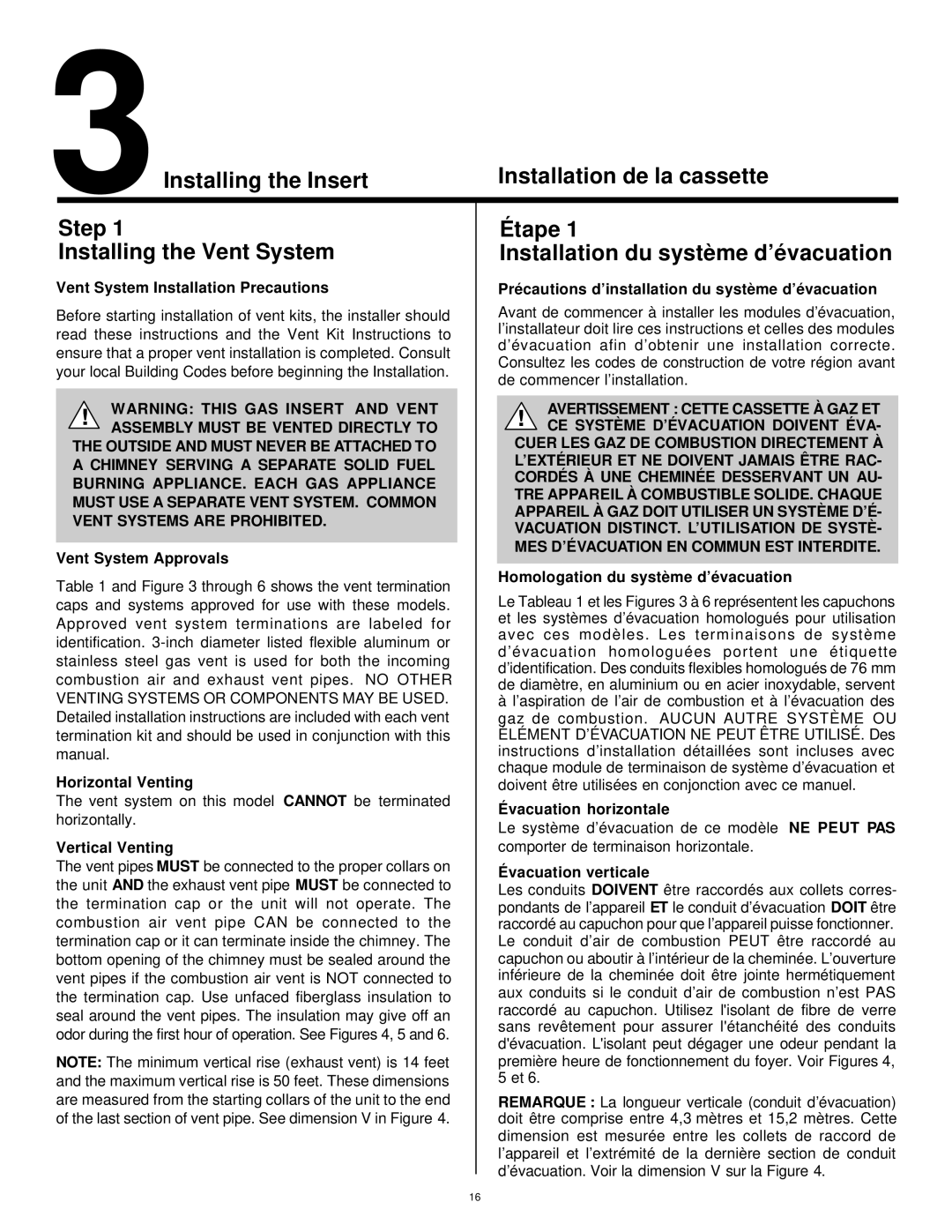
3Installing the Insert
Step 1
Installing the Vent System
Vent System Installation Precautions
Before starting installation of vent kits, the installer should read these instructions and the Vent Kit Instructions to ensure that a proper vent installation is completed. Consult your local Building Codes before beginning the Installation.
!WARNING: THIS GAS INSERT AND VENT ASSEMBLY MUST BE VENTED DIRECTLY TO
THE OUTSIDE AND MUST NEVER BE ATTACHED TO A CHIMNEY SERVING A SEPARATE SOLID FUEL BURNING APPLIANCE. EACH GAS APPLIANCE MUST USE A SEPARATE VENT SYSTEM. COMMON VENT SYSTEMS ARE PROHIBITED.
Vent System Approvals
Table 1 and Figure 3 through 6 shows the vent termination caps and systems approved for use with these models. Approved vent system terminations are labeled for identification.
Horizontal Venting
The vent system on this model CANNOT be terminated horizontally.
Vertical Venting
The vent pipes MUST be connected to the proper collars on the unit AND the exhaust vent pipe MUST be connected to the termination cap or the unit will not operate. The combustion air vent pipe CAN be connected to the termination cap or it can terminate inside the chimney. The bottom opening of the chimney must be sealed around the vent pipes if the combustion air vent is NOT connected to the termination cap. Use unfaced fiberglass insulation to seal around the vent pipes. The insulation may give off an odor during the first hour of operation. See Figures 4, 5 and 6.
NOTE: The minimum vertical rise (exhaust vent) is 14 feet and the maximum vertical rise is 50 feet. These dimensions are measured from the starting collars of the unit to the end of the last section of vent pipe. See dimension V in Figure 4.
Installation de la cassette
Étape 1
Installation du système d’évacuation
Précautions d’installation du système d’évacuation
Avant de commencer à installer les modules d’évacuation, l’installateur doit lire ces instructions et celles des modules d’évacuation afin d’obtenir une installation correcte. Consultez les codes de construction de votre région avant de commencer l’installation.
AVERTISSEMENT : CETTE CASSETTE À GAZ ET ! CE SYSTÈME D’ÉVACUATION DOIVENT ÉVA- CUER LES GAZ DE COMBUSTION DIRECTEMENT À L’EXTÉRIEUR ET NE DOIVENT JAMAIS ÊTRE RAC- CORDÉS À UNE CHEMINÉE DESSERVANT UN AU- TRE APPAREIL À COMBUSTIBLE SOLIDE. CHAQUE APPAREIL À GAZ DOIT UTILISER UN SYSTÈME D’É- VACUATION DISTINCT. L’UTILISATION DE SYSTÈ- MES D’ÉVACUATION EN COMMUN EST INTERDITE.
Homologation du système d’évacuation
Le Tableau 1 et les Figures 3 à 6 représentent les capuchons et les systèmes d’évacuation homologués pour utilisation avec ces modèles. Les terminaisons de système d’évacuation homologuées portent une étiquette d’identification. Des conduits flexibles homologués de 76 mm de diamètre, en aluminium ou en acier inoxydable, servent
àl’aspiration de l’air de combustion et à l’évacuation des gaz de combustion. AUCUN AUTRE SYSTÈME OU ÉLÉMENT D’ÉVACUATION NE PEUT ÊTRE UTILISÉ. Des instructions d’installation détaillées sont incluses avec chaque module de terminaison de système d’évacuation et doivent être utilisées en conjonction avec ce manuel.
Évacuation horizontale
Le système d’évacuation de ce modèle NE PEUT PAS comporter de terminaison horizontale.
Évacuation verticale
Les conduits DOIVENT être raccordés aux collets corres- pondants de l’appareil ET le conduit d’évacuation DOIT être raccordé au capuchon pour que l’appareil puisse fonctionner. Le conduit d’air de combustion PEUT être raccordé au capuchon ou aboutir à l’intérieur de la cheminée. L’ouverture inférieure de la cheminée doit être jointe hermétiquement aux conduits si le conduit d’air de combustion n’est PAS raccordé au capuchon. Utilisez l'isolant de fibre de verre sans revêtement pour assurer l'étanchéité des conduits d'évacuation. L'isolant peut dégager une odeur pendant la première heure de fonctionnement du foyer. Voir Figures 4, 5 et 6.
REMARQUE : La longueur verticale (conduit d’évacuation) doit être comprise entre 4,3 mètres et 15,2 mètres. Cette dimension est mesurée entre les collets de raccord de l’appareil et l’extrémité de la dernière section de conduit d’évacuation. Voir la dimension V sur la Figure 4.
16
